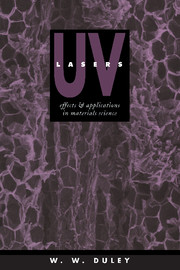Book contents
- Frontmatter
- Contents
- Preface
- Acknowledgments
- 1 Short wavelength lasers
- 2 Optical properties of materials at UV wavelengths
- 3 Photochemical and photothermal effects
- 4 Interaction of UV laser radiation with metals
- 5 Interaction of UV radiation with organic polymers
- 6 Interactions and material removal in inorganic insulators
- 7 UV laser preparation and etching of superconductors
- 8 Interactions and effects in semiconductors
- 9 Laser deposition
- Index
4 - Interaction of UV laser radiation with metals
Published online by Cambridge University Press: 16 November 2009
- Frontmatter
- Contents
- Preface
- Acknowledgments
- 1 Short wavelength lasers
- 2 Optical properties of materials at UV wavelengths
- 3 Photochemical and photothermal effects
- 4 Interaction of UV laser radiation with metals
- 5 Interaction of UV radiation with organic polymers
- 6 Interactions and material removal in inorganic insulators
- 7 UV laser preparation and etching of superconductors
- 8 Interactions and effects in semiconductors
- 9 Laser deposition
- Index
Summary
ABSORPTION AND LATTICE HEATING
The initial stage in the conversion of laser radiation to heat during irradiation involves the excitation of electrons to states of higher energy. For this process to occur, vacant states have to be available to accept excited electrons. When the photon energy hν is small, as for example when 10.6 μm laser radiation is absorbed, only electrons with energies within a narrow range hν near the Fermi energy, ∈F, can participate in absorption. At 0 K, the highest energy reached upon absorption is ∈F + hν.
At higher temperatures, electrons occupy a range of states given by the Fermi–Dirac distribution (Omar 1975). This reduces to a Boltzmann function for electron energies ∈ such that ∈ – ∈F ≫ kT, where T is the metal temperature. Absorption of photons then populates those states with energy ∈ + hν. Since ∈F is usually several electronvolts, whereas hν = 0.117 eV for CO2 laser photons, absorption of IR laser radiation then acts to redistribute electrons among states close to those on the Fermi surface.
This situation is different at excimer laser wavelengths, since hν is then comparable to or larger than the work function, φ, of many metals. When hν > φ, electrons may be directly excited from states near the Fermi surface to continuum states associated with the ejection of an electron from the metal. These electrons will originate from levels within the skin depth, δ. Those electrons that are not ejected will dissipate their excess energy as heat within the skin depth.
- Type
- Chapter
- Information
- UV LasersEffects and Applications in Materials Science, pp. 98 - 147Publisher: Cambridge University PressPrint publication year: 1996



